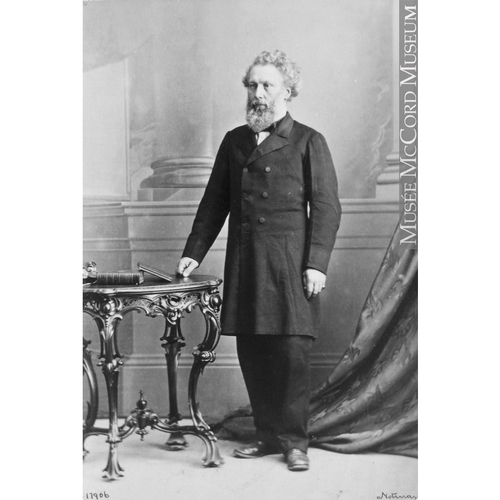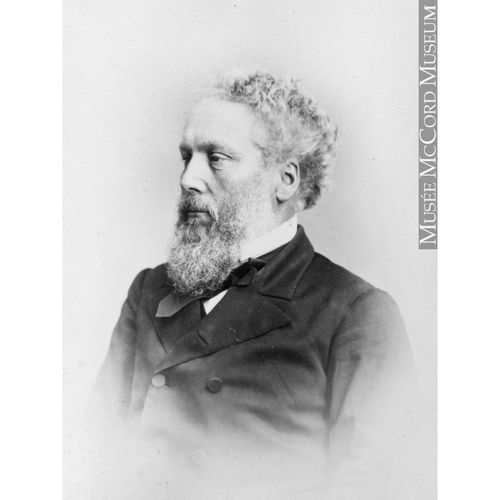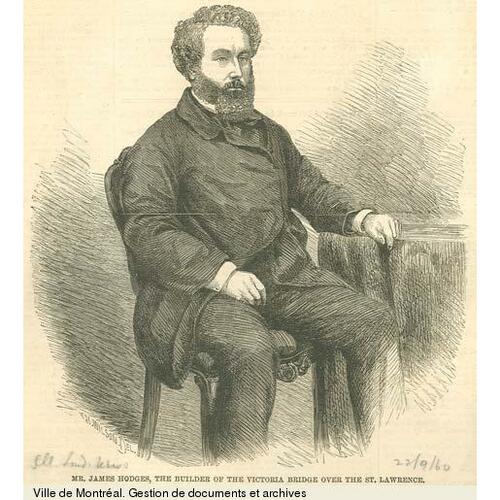
Source: Link
HODGES, JAMES, engineer; b. 6 April 1814 at Queenborough, Kent, Eng.; d. 28 May 1879 on his estate of Penny-Hill at Bagshot, Surrey, Eng.
In Queenborough James Hodges received only an elementary education, and he took advantage of the industrial revolution to carve out a place for himself. He was apprenticed to a Brompton contractor at the age of 17, and soon turned to railway construction, taking part in some ten important projects and becoming works manager of the South-Eastern Railway Company. After that, as Sir Samuel Morton Peto’s agent, he worked at the building of the suspension bridges at Norwich, Needham, and Somerleyton, accepted a post as engineer, and then undertook the construction of 50 miles of track for the Great Northern Railway.
With this valuable experience to help him, Hodges arrived in Canada in 1853 to represent the firm of Peto, Brassey, and Betts, which had just signed a contract with the Grand Trunk Railway Company. Until 1860 he directed the gigantic task of building a bridge (Victoria Bridge) over the St Lawrence near Montreal. He had to tackle numerous technical problems resulting from the speed and strength of the current and the intense cold of the winters. Furthermore, he could not count on a stable work force. The fitters and labourers, dissatisfied with the wage offers made them, periodically went on strike; some were signed on by other contractors who offered them better wages. Drownings occurred; cholera and blindness due to the reflection of the sun on the ice affected a considerable number of workmen. However, thanks to the assistance given by five doctors, the number of deaths among the 3,040 men employed during these six years was kept down to 26. The workers lived on the banks of the river, and had the advantage of a chapel, a school, and a library of some 1,000 volumes.
The Grand Trunk Railway Company wanted to do away as soon as possible with the ferry linking the two banks, which would lighten its annual budget by about £2,500. The contractors therefore decided in June 1858 to try to open the bridge to traffic by the following year. To meet this objective, Hodges used the support of the ice to place in position during the winter of 1858–59 the central deck of the bridge and its tubular structure, which measured 330 feet in length and weighed 771 tons. By this daring operation he completed his task before the time provided for in the contract. This achievement earned him the honour, on 25 Aug. 1860, of welcoming the Prince of Wales, the future Edward VII, who had come specially to open the bridge, named Victoria after the reigning sovereign.
His work ended, Hodges returned to England. But he soon found himself alone once more, as a result of his wife’s death. In 1863 he came back to Montreal as the agent of the Grand Trunk, and endeavoured to obtain a cheap form of fuel for Canadians, who lacked coal. He developed a peatbog on a 25,000 acre tract of land near the railway in the township of Bulstrode (Arthabaska County), which had been granted to him in May 1869. He met with little success and shortly before 1871 he returned to England to his estate in Surrey, where he died in 1879.
James Hodges, Construction of the great Victoria Bridge in Canada (2v., London, 1860). Langelier, Lands granted in Quebec, 1763–1890, 65, 1465. Le Courrier du Canada (Québec), 31 août 1860. Morning Chronicle (Quebec), 27 Aug. 1860. Morgan, Sketches of celebrated Canadians, 706–8. Notman and Taylor, Portraits of British Americans, I, 267–92. A. W. Currie, The Grand Trunk Railway of Canada (Toronto, 1957), 51. Raphaël Bellemare, “Inauguration du pont Victoria,” BRH, V (1899), 189–90.
Cite This Article
Jacques Mathieu, “HODGES, JAMES,” in Dictionary of Canadian Biography, vol. 10, University of Toronto/Université Laval, 2003–, accessed December 28, 2025, https://www.biographi.ca/en/bio/hodges_james_10E.html.
The citation above shows the format for footnotes and endnotes according to the Chicago manual of style (16th edition). Information to be used in other citation formats:
| Permalink: | https://www.biographi.ca/en/bio/hodges_james_10E.html |
| Author of Article: | Jacques Mathieu |
| Title of Article: | HODGES, JAMES |
| Publication Name: | Dictionary of Canadian Biography, vol. 10 |
| Publisher: | University of Toronto/Université Laval |
| Year of publication: | 1972 |
| Year of revision: | 1972 |
| Access Date: | December 28, 2025 |






